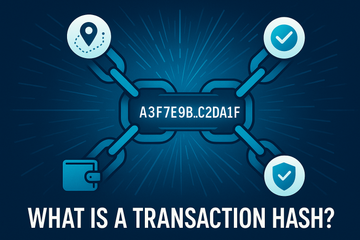If you’ve ever watched your cryptocurrency leave your wallet and vanish into cyberspace, you probably encountered a string of letters and numbers—a transaction hash. Maybe you squinted at it, wondering if someone just smacked their keyboard. What does it all mean? Let’s unravel this not-so-mysterious piece of crypto that quietly keeps the whole show running.
So, What’s a Transaction Hash Anyway?
Picture a library filled with millions of books, each one telling its own story. Now, imagine trying to point to a specific page in a single book just by describing the storyline. Impossible, right? That’s where the transaction hash—or txid if you’re feeling fancy—comes in. It's a one-of-a-kind, alphanumeric fingerprint, generated by cryptographic algorithms, that labels every single transaction on the blockchain.
But why all the fuss? Well, without these unique hashes, tracking transactions in this ocean of digital transfers would be like looking for a grain of sand in the desert. Your hash is your transaction’s ID card—inscribed onto the public blockchain, forever.
Strings That Matter: How Does It Work?
Here’s the thing: a transaction hash isn’t just a randomized mess. It’s the result of firing up math so complex, it’s basically wizardry. When you send Bitcoin, Ethereum, or any other coin, the network collects all the transaction details (think sender, receiver, amount), bundles them up, and runs them through a cryptographic hash function. Most blockchains use SHA-256 or similar cryptographic algorithms. The output is your transaction hash—something like 4e944bda7b3a… (except about thirty more characters tacked on).
And it’s not just some boring identifier. Change a single detail—seriously, one digit—and you get an entirely different hash. There’s no fudging the numbers here; the process is deterministic, irreversible, and tamper-proof.
Let Me Explain With an Analogy
Remember those childhood days with secret decoder rings or when a simple lemon juice scribble was your ultimate secret message? A transaction hash functions kind of like that, translating a dense pile of transaction data into a secret code. But instead of just impressing your friends at recess, it’s impressing, oh, the entire world’s worth of blockchain participants.
Why Should You Care About Transaction Hashes?
Now, you might ask yourself, “Okay, so what’s it really matter to me?” Well, two words: traceability and transparency. Every transfer or smart contract call leaves a breadcrumb trail. If you’ve ever waited on a wire transfer, nervously chewing your nails, crypto offers something most banks couldn’t dream of—a real-time, public, and immutable recap of your funds journey.
- Verification: Plug that hash into a blockchain explorer (think of it like Googling your transaction), and you’ll see the transaction status. No customer support hold times or cryptic bank statements.
- Proof: Need to show someone you paid them? Share the hash. They can confirm instantly. No more “the check’s in the mail” excuses.
- Dispute Resolution: If anyone claims funds went missing or didn’t arrive, the hash stands as an impartial witness. It can’t fabricate stories or play favorites.
In the crypto world, this level of verifiability is more than a feature—it’s peace of mind. And really, who doesn’t want that?
The Blockchain Wallet Connection (A Quick Tangent)
Say you’re storing Bitcoin in a hardware wallet—maybe you’re eyeing a Trezor or Ledger, two brands even old-school traders trust. When you send or receive coins, your wallet doesn’t just show a raw balance; it keeps a record of each transaction hash. That way, you can verify transactions, double-check addresses, or just relive the euphoria of your very first transfer. (Okay, maybe that’s just me.)
These wallets let you export or copy that transaction hash with a couple of taps, making it convenient to paste into any explorer or share with someone who’s waiting on that payment.
Hash & Seek: How to Find Your Transaction Hash
All this talk about transaction hashes is great, but where do you actually see one?
- Inside Your Wallet: Check the transaction history section; most platforms display the hash front and center.
- Via Blockchain Explorers: Etherscan (for Ethereum), Blockchain.com (for Bitcoin), or relevant explorers for whatever coin you’re using. Search your receiving or sending address—the hash shows up alongside transaction details.
Whether you’re troubleshooting a stuck transaction or just poking around, the hash is your trusty magnifying glass. Some explorers will even let you track confirmations in real time, updating each new block added to the chain.
Ever Had a Transaction Get Stuck?
If you’ve sent crypto and it seems to have vanished, your hash is your best friend. Blockchain explorers often show the status: “pending” or “confirmed.” If it’s stuck, it’s probably waiting for more network confirmations or maybe the network is congested. But at least you’re not totally in the dark—that’s more than we can say for old-fashioned wire transfers, right?
Security and Privacy Implications
Here’s something to chew on: while transaction hashes make blockchains more transparent, they don’t spill every secret. A hash itself doesn’t reveal your identity, amount, or even wallet balances—unless, of course, that info is already public or someone links your address to your real-world persona.
Still, every transaction is irrevocably etched into the blockchain. If privacy’s a concern (and let’s face it, sometimes it should be), consider privacy-focused coins or mixing services. But transparency does have its up side, especially when fighting fraud or proving payments.
Wrapping Up: The Humble Hash’s Heroics
You know what? At first glance, a transaction hash might seem like a throwaway detail. But the truth is, it’s quietly heroic—keeping records reliable, blockchains auditable, and transactions indisputable. From verifying those Saturday-morning Bitcoin buys to proving you really did pay that freelance designer in Bucharest, hashes bring clarity to the digital wild west.
Next time you see one, maybe let yourself smile. After all, behind every jumble of alphanumeric characters, there’s a story… and maybe a breakthrough in trustless digital finance. Even if you’re not a coder, you’re now in the club—hash in hand. Welcome.











